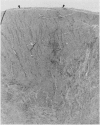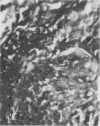Abstract
The standard coronary ligation model for experimental myocardial infarction results in variable areas and patterns of necrosis; therefore, the healing of such infarctions is also variable. The authors developed an experimental myocardial injury model using simple cryoinjury, which allows standardization of the size, depth, and location of the wound. Thirty-eight left ventricular cryolesions were created in 19 dogs, which were then killed from 3 to 35 days after injury. A consistent decrease in the depth of scar (p less than 0.005) and accumulation of collagen (p less than 0.0001) over time characterized this healing myocardial wound. Histologic examination revealed that the cellular pattern of healing myocardial cryolesions is similar to that of a healing myocardial infarction but with less variability. The authors advocate the use of cardiac cryolesions as a model of experimental myocardial wound healing.
Full text
PDF





Images in this article
Selected References
These references are in PubMed. This may not be the complete list of references from this article.
- Brown E. J., Jr, Kloner R. A., Schoen F. J., Hammerman H., Hale S., Braunwald E. Scar thinning due to ibuprofen administration after experimental myocardial infarction. Am J Cardiol. 1983 Mar 1;51(5):877–883. doi: 10.1016/s0002-9149(83)80148-9. [DOI] [PubMed] [Google Scholar]
- Eaton L. W., Bulkley B. H. Expansion of acute myocardial infarction: its relationship to infarct morphology in a canine model. Circ Res. 1981 Jul;49(1):80–88. doi: 10.1161/01.res.49.1.80. [DOI] [PubMed] [Google Scholar]
- Fishbein M. C., Maclean D., Maroko P. R. The histopathologic evolution of myocardial infarction. Chest. 1978 Jun;73(6):843–849. doi: 10.1378/chest.73.6.843. [DOI] [PubMed] [Google Scholar]
- GRANT R. A. ESTIMATION OF HYDROXYPROLINE BY THE AUTOANALYSER. J Clin Pathol. 1964 Nov;17:685–686. doi: 10.1136/jcp.17.6.685. [DOI] [PMC free article] [PubMed] [Google Scholar]
- Gallagher J. J., Anderson R. W., Kasell J., Rice J. R., Pritchett E. L., Gault H. J., Harrison L., Wallace A. G. Cryoablation of drug-resistant ventricular tachycardia in a patient with a variant of scleroderma. Circulation. 1978 Jan;57(1):190–197. doi: 10.1161/01.cir.57.1.190. [DOI] [PubMed] [Google Scholar]
- Klein G. J., Harrison L., Ideker R. F., Smith W. M., Kasell J., Wallace A. G., Gallagher J. J. Reaction of the myocardium to cryosurgery: electrophysiology and arrhythmogenic potential. Circulation. 1979 Feb;59(2):364–372. doi: 10.1161/01.cir.59.2.364. [DOI] [PubMed] [Google Scholar]
- Laks H., Hammond G., Geha A. S. Use of silicone rubber as a pericardial substitute to facilitate reoperation in cardiac surgery. J Thorac Cardiovasc Surg. 1981 Jul;82(1):88–92. [PubMed] [Google Scholar]
- TAYLOR C. B., DAVIS C. B., Jr, VAWTER G. F., HASS G. M. Controlled myocardial injury produced by a hypothermal method. Circulation. 1951 Feb;3(2):239–253. doi: 10.1161/01.cir.3.2.239. [DOI] [PubMed] [Google Scholar]
- Yamazaki Y., Eguchi S., Terashima M., Matsuzawa H., Asano K. A surgical treatment with an "on-lay" patch for experimental myocardial infarction. J Cardiovasc Surg (Torino) 1977 Mar-Apr;18(2):191–197. [PubMed] [Google Scholar]







